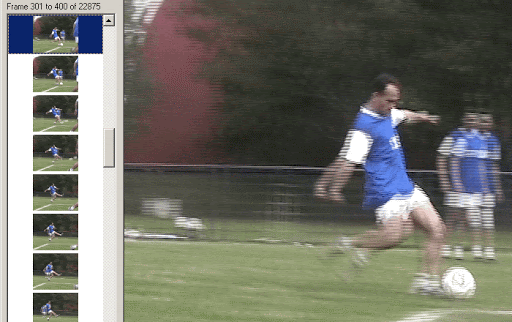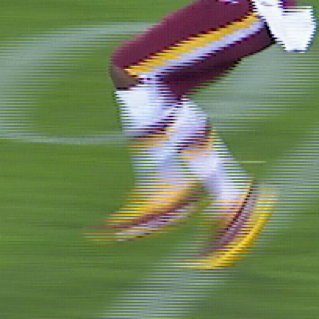We'd like to remind Forumites to please avoid political debate on the Forum... Read More »
📨 Have you signed up to the Forum's new Email Digest yet? Get a selection of trending threads sent straight to your inbox daily, weekly or monthly!
bad picture when connect laptop to tv via hdmi cable
Comments
-
Thanks, the reason I asked is because that effect is caused by interlacing. So if the mode was 1080i instead of 1080p then that is the effect that occurs - any way to check what the TV is displaying resolution wise and see whether it is "i" or "p" mode?gingerbreadmen said:
no where near as bad as that, In the last picture its like the top of his leg. But maybe there are not moving as fast as this man lol.[Deleted User] said:Is it this effect?

Also just another thought, are you displaying the same as the laptop screen (mirroring) or is the TV acting as a second screen?
If you a mirroring it could be that the laptop screen native resolution is a mismatch with TV screen, eg laptop is 1366x768 and the TV is 1920x1080 and therefore it needs to be upscaled by the TV causing extra processing of the image. The way to solve this would be connect as an extension to the desktop then the TV will display in native mode ok.
Regarding the refresh rate, as far as I can find on the internet, the TV model you mentioned can do 60Hz so that shouldn't be an issue.2 -
Hi thanks for all the info. Iam mirroring the laptop screen to the tv. I'll try it as a second screen if i can find out how to do it lol. Ive gone into the menu of the Tv and you can change it from 50Hz to 60Hz but makes no difference.[Deleted User] said:
Thanks, the reason I asked is because that effect is caused by interlacing. So if the mode was 1080i instead of 1080p then that is the effect that occurs - any way to check what the TV is displaying resolution wise and see whether it is "i" or "p" mode?gingerbreadmen said:
no where near as bad as that, In the last picture its like the top of his leg. But maybe there are not moving as fast as this man lol.[Deleted User] said:Is it this effect?

Also just another thought, are you displaying the same as the laptop screen (mirroring) or is the TV acting as a second screen?
If you a mirroring it could be that the laptop screen native resolution is a mismatch with TV screen, eg laptop is 1366x768 and the TV is 1920x1080 and therefore it needs to be upscaled by the TV causing extra processing of the image. The way to solve this would be connect as an extension to the desktop then the TV will display in native mode ok.
Regarding the refresh rate, as far as I can find on the internet, the TV model you mentioned can do 60Hz so that shouldn't be an issue.0 -
gingerbreadmen said:Hi thanks for all the info. Iam mirroring the laptop screen to the tv.I'll try it as a second screen if i can find out how to do itFirst post here ....
1 -
Hi Thanks did that and its still the same. I think I may just have to put up with it. Maybe the stream is not good enough, As watching sport on YT works ok.J_B said:gingerbreadmen said:Hi thanks for all the info. Iam mirroring the laptop screen to the tv.I'll try it as a second screen if i can find out how to do itFirst post here ....0 -
Ive even tried it through fire stick direct onto the tv (as suggested on the thread that J B kindly gave ) and it still flickers the picture is great its just when the players move.0
-
I took a quick look at the TV specs and it says it has an 800Hz refresh rate, so that should be quick enough to avoid significant motion blur. So it could be the source - a combination of the stream and the laptop output to the TV.1
-
Yes I think it must be the source. As its the same if i watch it directly on the tv without laptop. Thats a shame I was hoping to be able to sort it out.Were_Doomed said:I took a quick look at the TV specs and it says it has an 800Hz refresh rate, so that should be quick enough to avoid significant motion blur. So it could be the source - a combination of the stream and the laptop output to the TV.0 -
It doesn't have an 800Hz refresh rate, no TV panel does, that is marketing garbage from Samsung otherwise known as PQI (Picture Quality Index) and is often quoted in sales literature to compare picture processing rates but I can guarantee the panel on the TV is not 800Hz.Were_Doomed said:I took a quick look at the TV specs and it says it has an 800Hz refresh rate, so that should be quick enough to avoid significant motion blur. So it could be the source - a combination of the stream and the laptop output to the TV.
Common panel refresh rates are 50/60/100/120/240 with the upper end usually only appearing in high end gaming monitors.
If you want to compare the "800 Hz" PQI figure look at current Samsung models, usually quoting 1300 - 2700 on current models but they cannot be compared like for like with other manufacturers.1 -
Since the OP confirms that the laptop screen experiences the same issue then perhaps refresh rate is a moot point ... but would you happen to know what Samsung panels can accommodate? (A good LCD panel in a PC monitor for example would have 4ms refresh or perhaps even better. 50Hz equates to 20ms, so 240Hz would be 4.167ms).0
-
You are mixing up pixel response times with refresh rates. Pixel response times are measured in milliseconds and as you say a good panel in a PC monitor will be 4ms or less. This is the time it takes a pixel to go from full off to full on or vice versa.Were_Doomed said:Since the OP confirms that the laptop screen experiences the same issue then perhaps refresh rate is a moot point ... but would you happen to know what Samsung panels can accommodate? (A good LCD panel in a PC monitor for example would have 4ms refresh or perhaps even better. 50Hz equates to 20ms, so 240Hz would be 4.167ms).
Refresh rate is the frequency of updating the whole screen with a new frame. If you are running 50 Hz with 4ms pixel response time, then that means that for the 20ms each frame is displayed, 4ms of that time (20%) is taken up by the pixels responding to the new state.
Potentially the pixels are in the wrong state of 20% of the time in the above example, but in reality most pixels won't change much from frame to frame, except where motion is occurring.
Agreed refresh rate isn't the issue with the OP, probably image processing ability of the laptop. Samsung panels will vary from 1ms up to 10ms depending on the model, in any case, all independent of refresh rate.
.1
Confirm your email address to Create Threads and Reply

Categories
- All Categories
- 351.3K Banking & Borrowing
- 253.2K Reduce Debt & Boost Income
- 453.8K Spending & Discounts
- 244.3K Work, Benefits & Business
- 599.5K Mortgages, Homes & Bills
- 177.1K Life & Family
- 257.8K Travel & Transport
- 1.5M Hobbies & Leisure
- 16.2K Discuss & Feedback
- 37.6K Read-Only Boards




